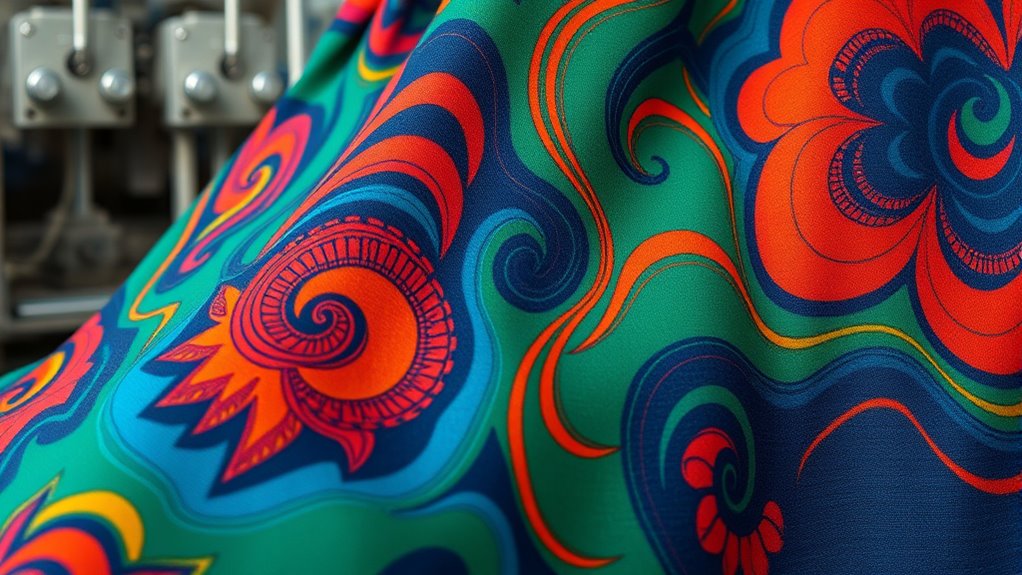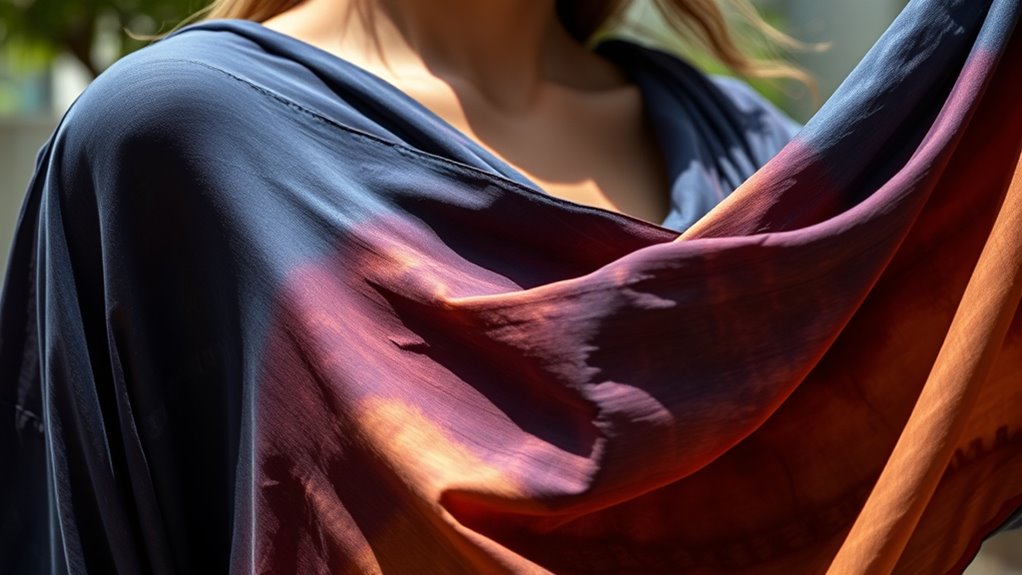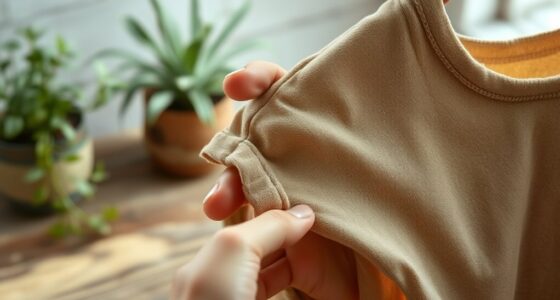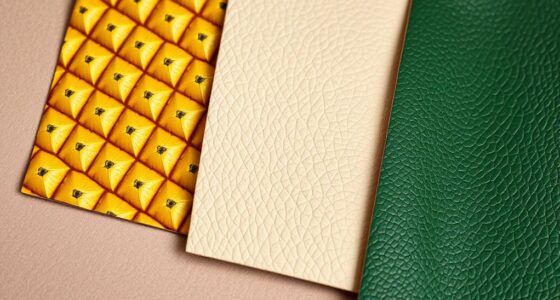Waterless dyeing technologies like supercritical CO₂, foam dyeing, and digital printing are changing how your wardrobe impacts the environment. They use less water, energy, and harmful chemicals while delivering bright, long-lasting colors. These innovations help reduce pollution and waste, making fashion more sustainable. By choosing clothing made with waterless dyeing, you support eco-friendly practices and stylish, durable garments. If you want to explore how these technologies can transform your wardrobe further, keep going.
Key Takeaways
- Uses eco-friendly techniques like supercritical CO₂, foam dyeing, and digital printing to reduce water and chemical use.
- Operates at lower temperatures and energy levels, making the dyeing process more sustainable and efficient.
- Produces vibrant, durable colors that resist fading, reducing the need for re-dyeing and waste.
- Eliminates water pollution and toxic chemicals common in traditional dyeing methods.
- Supports eco-conscious fashion by enabling brands to offer sustainable, vibrant garments, transforming your wardrobe’s environmental impact.

Waterless dyeing technologies are transforming the textile industry by offering a sustainable alternative to traditional dyeing methods. Instead of using vast amounts of water and chemicals, these innovations rely on eco friendly chemicals and energy efficient processes that considerably reduce environmental impact. By choosing fabrics dyed through waterless methods, you’re supporting a more sustainable fashion industry that minimizes water pollution, conserves resources, and reduces energy consumption. This shift means your wardrobe can be stylish without contributing to the ecological footprint of conventional dyeing.
Waterless dyeing reduces environmental impact by using eco friendly chemicals and energy-efficient processes.
Traditional dyeing processes demand enormous water volumes and often involve toxic chemicals that can harm ecosystems and human health. Waterless dyeing eliminates the need for large water tanks, replacing them with innovative techniques like supercritical CO₂, foam dyeing, or digital printing, all of which use little to no water. These processes harness eco friendly chemicals that are less harmful and more sustainable, ensuring that dyeing is safer for both the environment and workers involved. This not only reduces waste and pollution but also curtails the energy-intensive steps associated with conventional dyeing, making it a smarter choice for eco-conscious consumers.
Energy efficiency is at the core of waterless dyeing technologies. Unlike traditional dyeing, which consumes massive amounts of energy for heating and water management, waterless methods often operate at lower temperatures or utilize processes that require less energy overall. For example, supercritical CO₂ dyeing uses carbon dioxide in a fluid state to transfer dyes onto fabrics, drastically cutting energy use and water consumption. This process is faster, more efficient, and produces less waste, meaning your clothes can be produced with a smaller carbon footprint. As a consumer, supporting brands that adopt energy-efficient processes encourages a shift toward more sustainable manufacturing practices, ultimately leading to a greener wardrobe.
Moreover, waterless dyeing opens doors to more vibrant and diverse colors without the environmental toll. Because these methods allow precise control over dye application, you get high-quality, long-lasting colors that resist fading. This durability means fewer re-dyes and less waste over the lifecycle of your clothing. By choosing garments made with waterless dyeing, you’re not only investing in style but also championing a cleaner, greener planet. As these technologies become more widespread, you’ll find that sustainable fashion can be both trendy and responsible, aligning your personal values with your wardrobe choices. Additionally, advancements in waterless dyeing are making it possible to achieve vibrant colors that rival traditional methods, further enhancing its appeal for fashion-conscious consumers.
Frequently Asked Questions
How Durable Are Waterless Dyed Garments Compared to Traditional Dyes?
Waterless dyed garments typically offer comparable durability to traditional dyes. You’ll find that fiber longevity remains strong, and color retention is often excellent over time. Because waterless dyeing minimizes chemical use and stress on fibers, your clothes tend to stay vibrant longer. You can enjoy garments that resist fading and maintain their quality, making waterless dyeing a sustainable and durable alternative for your wardrobe.
What Are the Environmental Impacts of Waterless Dyeing Processes?
You’ll be glad to know that waterless dyeing processes substantially reduce water consumption, helping conserve this essential resource. They also minimize chemical runoff, lowering pollution and environmental harm. Unlike traditional dyeing methods, waterless techniques cut down on wastewater and hazardous chemicals, making your wardrobe more eco-friendly. By choosing waterless dyeing, you actively support sustainable fashion, reducing your environmental footprint and promoting cleaner water systems for communities worldwide.
Can Waterless Dyeing Be Applied to All Fabric Types?
Think of waterless dyeing like a master chef choosing the right ingredients. Not all fabrics are a perfect match; some, like polyester and nylon, absorb dyes well, while others, like cotton, may need adjustments. You need to take into account fabric compatibility and dye absorption to ensure vibrant, lasting colors. So, waterless dyeing isn’t universal—its success depends on matching the technology to each fabric’s unique properties.
Is Waterless Dyeing Cost-Effective for Large-Scale Production?
You might wonder if waterless dyeing is cost-effective for large-scale production. While it can reduce water and energy costs, a thorough cost analysis shows initial investment and scalability challenges can be significant. You’ll need to weigh these factors carefully, considering long-term savings against setup expenses. If you navigate the scalability challenges well, waterless dyeing could become a cost-efficient, sustainable choice for your large-scale manufacturing needs.
How Do Waterless Dyes Influence Color Vibrancy and Variety?
Waterless dyes can enhance color vibrancy and variety in your wardrobe by providing better control over color intensity and shade range. You’ll notice brighter, more consistent hues and a broader spectrum of shades, thanks to precise dye application. This technology reduces environmental impact while maintaining or even improving color quality. As a result, your clothing options become more vibrant and diverse without sacrificing sustainability or durability.
Conclusion
By embracing waterless dyeing tech, you’re stepping into a future where your wardrobe helps save the planet. Think of it as sailing a ship through uncharted waters, leaving behind the chaos of traditional methods. With each eco-friendly garment, you’re part of a revolution—like discovering a hidden city beneath the waves. So, choose sustainably, wear consciously, and let your style lead the charge into a cleaner, greener world. The future’s waiting, and it’s looking sharp.









